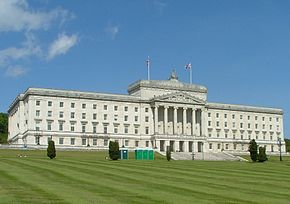Parliament of Northern Ireland
The Parliament of Northern Ireland ( Parliament of Northern Ireland ) was by the Government of Ireland Act created in 1920 and was in the wake of the escalating Northern Ireland conflict resolved. It originally came from the Home Rule of 1914, which provided for an independent Irish parliament. In the same train as the Parliament of Northern Ireland was Parliament of Southern Ireland created.
The Parliament of Northern Ireland consisted of two chambers:
- the elected House of Commons, the House of Commons of Northern Ireland
- the largely powerless House of Lords, the Senate of Northern Ireland
history
The first election to the House of Commons of the Parliament of Northern Ireland took place on May 24, 1921. The Protestant Ulster Unionist Party (UUP) won 40 of the 52 seats. At an opening in Belfast City Hall on June 7, 1921 , King George V made an important proposal for a reconciliation between North and South. The speech, drafted by David Lloyd George on the recommendation of Jan Smuts , opened the door for formal contact between the British government and the Republican administration under Éamon de Valera . In June 1922, the third Dáil was elected as the constituent assembly in southern Ireland , with Northern Ireland immediately leaving the Irish Free State created by the treaty . After the electoral victory of those in favor of the treaty in the south, the Irish Civil War (1922–1923) broke out.
The Government of Ireland Act of 1920 remained the basic law for the government of Northern Ireland until 1972. The House of Commons had majority voting and the constituency boundaries had been adjusted in such a way that the Catholics, who were already in the minority, were further disadvantaged ( gerrymandering ). As a result, this parliament was dominated by the Protestant UUP, which was the government of Northern Ireland throughout the existence of the Parliament of Northern Ireland .
On January 30, 1972 came in the wake of the escalating Northern Ireland conflict for so-called Bloody Sunday ( Bloody Sunday ): In Derry were at a demonstration against the policies Interment at least 14 unarmed Catholics, including six minors, by British paratroopers killed. As a result, there was a strong influx of the IRA and acts of terrorism by various groups (on the part of the Irish nationalists, above all the IRA , on the part of the unionists, for example the Ulster Defense Association ), which killed many civilians.
In March 1972 the British government suspended the Northern Irish Parliament and Northern Ireland was ruled from London by a Northern Ireland Minister from March 24th ("Direct Rule"). The Parliament of Northern Ireland was also formally dissolved by the Northern Ireland Constitution Act of 1973.
successor
Under the agreement of Sunningdale in 1973 was in its place Northern Ireland Assembly formed next to the Irish Council ( Council of Ireland ) and the Northern Ireland Executive . It was lifted a year later because radicals on both sides refused to accept it. In 1982, another assembly was set up, an organ with little authority, which was dissolved again in 1986 due to the lack of support from the Catholic side. The modern Northern Ireland Assembly was elected for the first time on June 25, 1998 in the course of implementing the Good Friday Agreement and held its first session on July 1 of the same year.
